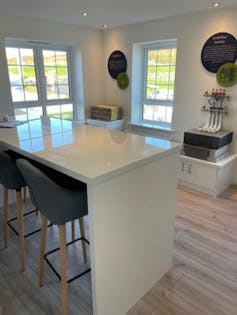
Forty percent of UK greenhouse gas emissions come from households, so the sustainable construction and everyday running of our homes could play a major role in achieving a low-carbon society.
Next year, the government will introduce the future homes standard. It’s a new regulation that bans the installation of gas boilers in new homes and takes other steps to ensure an 80% reduction in operational carbon – that’s the way we measure the occupation of homes and the energy we use.
I work with a team of researchers at the Centre for Future Homes, a research facility focused on how to design, construct, commission and operate net zero ready homes in the most practical and efficient way.
Over the past three years, we have been studying energy consumption at a development of 12 homes that have been purpose built by a housing association called Midland Heart, on brownfield land in Handsworth, Birmingham. As part of an initiative called Project 80, these houses have been designed to meet the proposed future homes standard.

The transition to net zero must be balanced against the need to ensure building safety, avoiding the use of combustible materials, where possible, following the Grenfell Tower tragedy in London in 2017.
Sensors have been installed in each of the 12 houses to measure a range of parameters in real time, such as indoor air quality, overheating, cooking preferences and the performance of heat pumps and hot water storage in these new fully occupied homes.
Each home is occupied by social housing tenants and the occupants have all told us that they are happy with their homes. One family hasn’t suffered from pre-existing asthma since moving into their new home in 2022.
Our research can help shape the future of new build homes because the data we collate will provide the industry with real evidence and measured outcomes rather than modelled scenarios. Good communication and collaboration between everyone involved, from architects to energy assessors and product suppliers makes it much easier to deliver high-quality, energy-efficient homes.

These homes have all been built using locally sourced, non-combustible and insulated brick and block so they are extremely thermally efficient. The buildings are all installed with heat pumps and solar PV panels to provide renewable electricity. The homes have different levels of air tightness to allow us to compare and contrast different ways of meeting the new standard.
Behind closed doors
Our team has recently completed two years of research, including regular interviews with occupants, to better understand their experience of living here. An interim report published in June 2023 highlights the need to engage and educate home occupiers about how to live in a more complex and gas-free home of the future.
Homes can perform very differently because of the way they are operated and maintained, so the way people live in their homes has a profound impact on the outcome. Some people like living at high temperatures, most open their windows even in winter and the amount of cooking varies.
We’re now looking at different tenures at the first future homes standard development by affordable housing developer Keepmoat with 33 homes for private sale and rent in Nottingham. We briefed all customer-facing sales staff and residents when they moved in to ensure everyone understood how to operate their new home effectively and keep energy bills as low as possible.
These homes are delivering a 91% carbon reduction and over the next year, we’ll gain more insights into how environmental outcomes depend on how residents consume energy and use their homes.
Our research shows that it’s possible to design and build comfortable, healthy and safe homes to meet the future homes standard, using local materials that are adaptable and built to last over 150 years.
But as homes become more complex, the importance of regular maintenance cannot be underestimated – the industry urgently needs to attract new workers and upskill existing ones to install and maintain the tech in all-electric homes. Residents need to be consulted at every stage so they are on board with running a net-zero home in the most energy-efficient and cost-effective way possible.

Don’t have time to read about climate change as much as you’d like?
Get a weekly roundup in your inbox instead. Every Wednesday, The Conversation’s environment editor writes Imagine, a short email that goes a little deeper into just one climate issue. Join the 35,000+ readers who’ve subscribed so far.
Mike Leonard does not work for, consult, own shares in or receive funding from any company or organisation that would benefit from this article, and has disclosed no relevant affiliations beyond their academic appointment.
This article was originally published on The Conversation. Read the original article.







